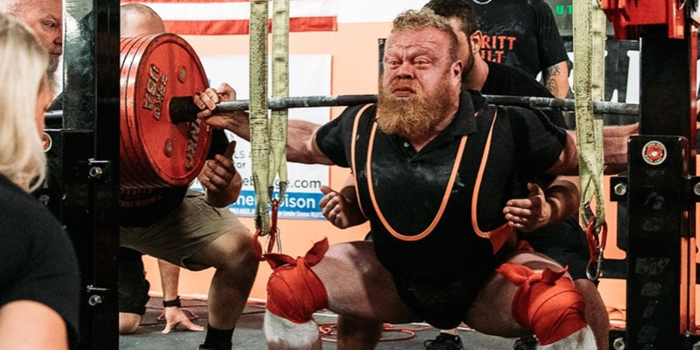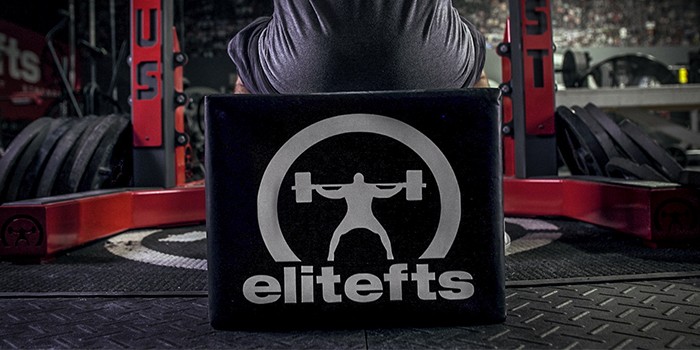
Header image courtesy of @sherm81
As a multi-ply lifter, I found the most success when I squatted almost exclusively to a box. I had developed my box squat so that when meet day came, nothing about my squat changed, other than not having a box to sit and pause on.
When I returned to raw lifting, instead of trying to re-invent my training, I took what I learned as a multi-ply lifter and applied that to training and competing without gear. During my last meet prep, I only took two heavy free squats, one at 10 weeks out, and one at two weeks out. The rest of my heavy squat training was done on a box.
WATCH: Equipment Feature — elitefts Squat Box
On meet day, my squat felt amazing. I wasn’t weak in the bottom. I wasn’t off balance. My form wasn’t sketchy. If anything, I felt the most dialed in, the most explosive, and the strongest that I ever have on a raw squat.
When I took the box away, my form didn’t change, and my groove didn’t change. The only thing that changed was instead of stopping and letting the box take some of the weight, I was able to incorporate a slight dip, catch some rebound, and explode out of the bottom.
I don’t attribute how well my squat went to box squats themselves — my squat was the result of learning how to do box squats in a way that made me a stronger free squatter.
At elitefts, I modified my box setup. I used this box and a pad.
If you are a lifter looking to add more box squats to your training, here are some considerations to make:
Squat with Confidence and Consistency
You need to be confident enough in your form that when you take the box away, there is zero hesitation. You need to know exactly where you need to be in the bottom and how it should feel. What is going to build that level of confidence? Practicing your free squat.
You need to know your free squat well enough that adding or removing the box won’t throw things off. You need to be confident enough in your free squat that adding or removing the box won’t change any critical component.
If you aren’t that confident in your free squat, all that means is that you need to free squat more frequently. If you are basing your training around box squats, how often should you free squat? Often enough that you have zero doubts in your ability to execute on meet day.
Box Squat the Way That You Free Squat
If you free squat with a close stance and tons of forward knee travel, you can’t expect to do anything but wide box squats with a vertical shin for three months and come back to your old technique and have it work right.
If you are getting started with box squats, they should be done very similarly to how you free squat, even if you are a narrow squatter. Your stance should be similar, and your shin angle in the bottom should be similar. The only real difference should be that you are sitting back to the box and that you are letting the box take some of the weight in the bottom. The box should not be stopping you in the bottom — you need to put on the breaks yourself before sitting on the box. The box isn’t a trampoline, and the box isn’t something to help catch your balance.
If you are box squatting similarly to how you free squat, when you take the box away, the only thing that will change is you are not stopping and letting the box take some of the load. With that, you won’t have to overcome a static, and you will be able to fully utilize your stretch reflex, getting rebound out of the bottom. Your free squat should and will be easier than your box squat.
READ MORE: Add 100 Pounds to Your Squat — 5 Seminar Takeaways
Be Honest With Yourself
Don’t set your box two inches high every week and expect to perform in meet conditions. Don’t flop onto the box and expect to be able to translate that to a free squat. Don’t get loose on the box and expect to stay tight without it. Don’t rock to get off the box and wonder why you can’t get out of the hole on a free squat.
If you are strict, precise, and deliberate with your box squats, that will carry over to a strict, precise, and deliberate free squat. Be honest with yourself. Be honest about how you are box squatting. Be honest with where your free squat really is. If box squats aren’t working for you, don’t place the blame on box squats without first considering how you are doing them.
In Closing
Yes, there are other ways to box squat, and other ways to make box squats work. There are countless other variables outside of the scope of this article. With that said, if you are getting started with box squatting, you aren’t going to go wrong if you are sure of your free squat form, are box squatting in a way that will carry over to your free squat, and are honest with yourself about technique, both on and off the box.
Seth Albersworth is a powerlifter with experience in and out of gear. His best totals are 2,000 pounds raw and 2,403 pounds multi-ply. Seth has completed his bachelor's degree in kinesiology from the University of Calgary and is currently studying to become a Doctor of Chiropractic at Palmer College of Chiropractic's Florida Campus.
Bonus Content By Dave Tate
20 Advantages of The Box Squat:
1. You can sit back more, allowing you to place emphasis on posterior chain.
2. It can gauge that you are squatting to the same height each time.
3. Allows the lifter to stop midpoint for technical corrections.
4. Allows for a static to dynamic contraction.
5. Most people can recover faster from box squats than other squats, so they can be trained more frequently.
6. It’s easier to teach and for a lifter to adapt to a different stance, albeit wide to close or close to wide.
7. Done properly, it could allow lifters with joint issues to still be able to squat but control range of motion or allow joint angles they can no longer do with free squats.
8. It allows the lifter to learn how to stay tight in the bottom position of the squat.
9. Is a great way to teach compensatory acceleration with the squat.
10. Easier to teach a straight concentric bar path.
11. Builds explosive strength.
12. For general population, there is no easier way I’ve found to teach the squat as well as a proper sit-to-stand for basic post rehab.
13. Can be used for lifters from complete beginner to the most advanced.
14. Great way to test different shin positions to see what will work best and/or what is the most comfortable for each lifter.
15. Can lower box height based on joint mobility and/or flexibility within the same set.
16. Along with #15, lower boxes can allow for ballistic stretching in the bottom of the squat position.
17. Allows coach to cue flex on command from bottom position without group feeling like their heads will pop off.
18. Breaking of the eccentric - concentric chain, allowing for more power development.
19. They have stood the test of time.
20. Because Louie says so...











4 Comments